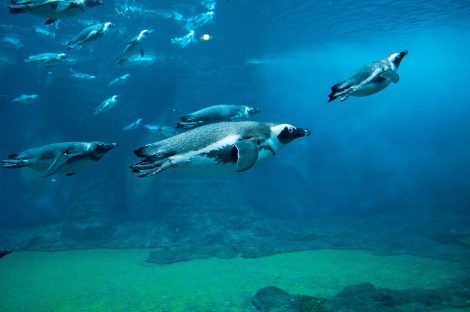Birds have light and fewer bones, unlike mammals. Mammals have strong but many bones when compared to birds. When it comes to flightless birds, they have different bones from the birds that can fly. Flightless birds like penguins do not have hollow bones. Their bones are filled and solid which makes them swim in the water easily.
Other flightless birds have marrow-filled bones like emu, kiwi, ostrich, cassowary, rhea, elephant bird and moa. They fall under the name ratites.
Penguins lost their ability to fly due to evolution and change in the environment. Not every flightless bird has solid bones. The extinct flightless bird “dodo” is one of the examples which have mostly hollow bones.
Evolution of Penguin’s Flightless Nature and Solid Bones:
Flightless birds like penguins progressed from the birds that could fly. Before 60 million years ago penguins’ ancestors flew over the ocean and plunged into the water like other marine birds.
Whales and penguins reside in the place where they can find abundant of food. Likewise, penguins moved to the place where they found enough prey and became endemic to those places. Millions of years ago, penguins developed their ability to be skillful divers and swimmers.
Penguins developed their ability to dive but they lost their ability to fly. Birds that fly have to be light in weight and have hollow bones but penguins transformed into bulky birds with solid bones. Thus, penguins found it difficult to carry the body for a flight and the solid bones restricted them from flying.

Greatest Advantages of Solid Bones:
The solid bones let the penguins to almost fly in the water more than swimming in the water. Penguin dives to the depth of 1000 m and also became an impeccable swimmer.
Emperor penguins can stay underwater for up to 20 minutes. The skill to stay underwater is also because of their bulky bodies. They can hold oxygen for a long time, unlike other marine animals.
Also, natural biological metabolism helps them master their skills. The solid bone balances the body and structures the unique creature for living in the marine.
The wing bones or the flipper bones of penguins are also strong which will be hard for the penguins to flap their wings to fly in the air. The driving efficiency is one of the significant behavior achieved by the solid bones.
There is a limit of weight for the birds to possibly fly, which is approximately around 15kg. The big stomach of the penguins has to be maintained and given way in the body which is done by the air sacs in their system. The air sacs aid the body to the surface when they finish searching the prey.
In the absence of air sac, penguins would have floated like swan or duck. Since the legs placed in the straight line of the body, penguins cannot fly above the ocean. Other birds that fly have the legs structured vertical to the ground; whereas, penguins’ legs are developed horizontally to the ground and hence they cannot float on the surface of the water.
The streamlined body with the legs backward does not require the penguin to paddle more as they are already in propulsion to surface. To propel the air sacs and the solid bones help them to reach.
The air sacs present in the bones of some birds are responsible for the flight which contributes in case of need while flying. Ostrich, kiwi, and penguins do not fly because they outsmart their predators in their way.
Ostrich can run faster more than its predator, kiwi had no natural predators to do the flying job and penguins do not fly because of their evolution and they are great swimmers.
Fortunately, birds have many thin bones in their body which aids them in flying, bending, floating, swimming, etc. Around 13 to 15 thin bones make the body structure of the flying bird.
Rich fabric blood vessels build the bones with the calcium from the body proteins, which is sufficient in penguin’s diet.
Conclusion:
Since birds’ bones are thin and can decay, there are no possible flying bird fossils found, whereas the colossus penguin’s fossils found in places of the Southern Hemisphere. The solid bones of penguins do not decay in the earth like human and mammal’s solid bones. Humans and other mammals’ bones are marrow-filled.
Dinosaurs that are related to birds also had hollow bones which were the evidence for flight. Almost all the birds that fly have air inside their bone than fluid or marrows. Lighter bones are helpful for flying but not for diving in the water, in this case, penguins are effective divers for the reason that they have solid bones.
References:
http://projectbeak.org/adaptations/skeletal.htm
http://www.pinguins.info/Engels/Evo_vlieg_eng.html
https://www.thenakedscientists.com/forum/index.php?topic=9622.0
https://www.britannica.com/animal/flightless-bird
https://www.factmonster.com/dk/encyclopedia/science/birds
Image Source: